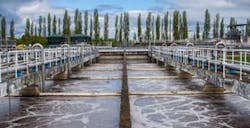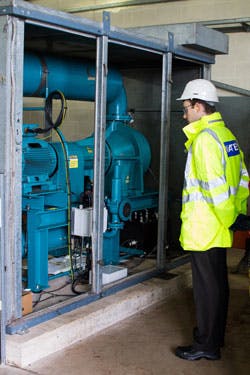Blowing Away the Bills
Cutting Through Aeration Energy Costs
In a bid to reduce the £9 million it spends annually on electricity to run 300 blowers, UK utility Severn Trent Water trialled a Blade Compressor as an alternative to the traditional blowers and compressors. If used across all of its wastewater treatment plants, a potential saving of £1.8 million per year could be saved.
By Steve Lindsey
Severn Trent Water is one of the largest of the ten regulated water and wastewater services companies in England and Wales, employing more than 5,000 people and serving around four million households and businesses across the heart of the UK.
In the UK, Severn Trent Water's territory stretches from the Bristol Channel to the Humber and from mid-Wales to the east Midlands. It delivers 1.8 million cubic metres of drinking water each day to customers through 47,000 kilometres of water mains. Wastewater is returned to the environment through a system comprising 93,000 kilometres of sewers and more than 1,000 wastewater treatment works.
High Energy Costs
Severn Trent's wastewater treatment works operate around the clock, handling more than 2.5 million cubic metres of wastewater every day. The utility spends around £9 million a year on electricity to run 300 blowers at its treatment works, more than half of the entire cost of wastewater treatment in the region. Industry estimates suggest that 1% of all of the UK's electricity is consumed by compressors used for the aeration of wastewater at the nation's utility businesses.
Given the cost of electricity consumption – and the associated CO2 emissions – Severn Trent Water has been investigating alternative solutions with lower energy costs, improved operational efficiency and reduced environmental impact.
Blade of Glory?
As a result, Severn Trent went onto trial Lontra's Blade Compressor. With a traditional piston and cylinder, as the piston drops down in the cylinder it draws in air above it and, as it goes up again, it compresses air in front of it.
In comparison, the Blade Compressor is best imagined as a piston and a cylinder, but with the piston wrapped around inside. There is a constantly open intake port, without valves. As the piston rotates, it induces a volume of air behind it in the same way as the piston dropping down in the cylinder. As it gets back to the starting point, it has induced a complete volume behind it. But unlike the traditional piston and cylinder that has to stop and change in direction, the blade passes through the disc with the volume that was trapped behind the piston now in front. This means that it has an almost continuous cycle of inducing air behind and compressing air in front.
Severn Trent worked for over a year with Lontra on a study evaluating its entire wastewater estate. Following initial results, Severn Trent agreed to part-fund a full scale trial alongside the Carbon Trust. The Blade Compressor's performance and reliability was then validated against existing machines, in a real time production environment, at Worcester Wastewater Treatment Works.
Mark Jones, Severn Trent's wastewater research and development manager, said: "To make the test as representative as possible, only the existing blower and motor were replaced, with the Blade Compressor fitted into an existing enclosure and running from an existing variable speed drive. This ensured that only the gains in the blower technology - and not those from optimising the supporting systems and drives - were captured."
In addition, the conventional blower that the Blade Compressor was to be compared against had been replaced just six months before the trial commenced, ensuring that the solution wouldn't have an unfair advantage by being tested against an ageing or worn alternative.
Results
The Blade Compressor was first run at Worcester in September 2012, running full time as a 'duty blower' without issues for more than seven months. The site's instrumentation and supervisory control and data acquisition system (SCADA) showed that the conventional blowers used more than 20% more electricity to deliver an equivalent amount of air when compared to the Blade Compressor
Severn Trent Water's chief executive Tony Wray, in his presentation of preliminary results to the City in May 2013, said that if the Blade Compressor was rolled out across all of Severn Trent's wastewater treatment works, the company could save more than £1.8 million a year in electricity costs, with a commensurate reduction in the company's overall carbon emissions of 3%. The savings prompted Severn Trent to consider a large scale replacement programme.
It was then decided that the on-site instrumentation for the Blade Compressor and the comparative blower should be upgraded to laboratory standard. Consultant ABB was engaged to specify and supply the instrumentation and the flowmeters were replaced by Orifice plates to ISO standard 5167.
Data from this instrumentation was logged for seven months between June 2013 and December 2013 over all conditions, from summer to winter, to provide operational results in a fully operational wastewater treatment works.
Severn Trent said: "Our upgraded instrumentation showed that from summer to winter the Lontra Blade Compressor used, on average, 21.2% less electricity to deliver an equivalent amount of air when compared to the existing blowers.
"Importantly for us, as well as being efficient, the machine is simple, using well understood and proven materials and engineering. The bearings are traditional and the rotor runs at low speed, being directly coupled to the motor without step-up gearboxes or belt drives."
Steve Lindsey is CEO of Lontra. For more information, email: [email protected]


